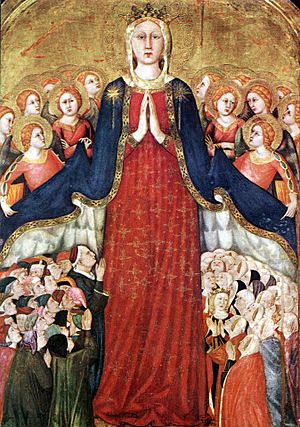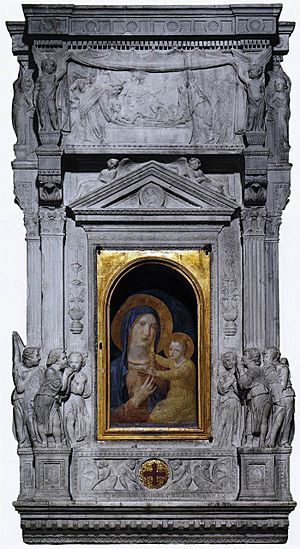Lippo Memmi facts for kids
Quick facts for kids
Lippo Memmi
|
|
|---|---|

Virgin of Mercy (Madonna dei Raccomandati), Orvieto Cathedral
|
|
| Born | c. 1291 Siena, Italy
|
| Died | 1356 Siena, Italy
|
| Known for | Painting |
| Movement | Sienese School |
Lippo Memmi was an Italian painter from Siena, a city in Italy. He lived from about 1291 to 1356. He was a very important student and follower of another famous painter, Simone Martini. Simone was also his brother-in-law!
In 1333, Lippo Memmi worked with Simone Martini on a famous painting called the Annunciation with St. Margaret and St. Ansanus. This painting is a masterpiece of the International Gothic style. Lippo probably painted the two saints in this artwork. He also helped paint at the Orvieto Cathedral, where he finished a piece called the Virgin of Mercy.
Later, he moved with Simone Martini to Avignon in France, where the Pope lived at the time. Lippo worked there for many years. He returned to Siena and continued painting until he passed away in 1356.
Memmi's famous painting, La Madonna della Febbre, was the first image of the Blessed Virgin Mary to be officially crowned by a Pope. This happened on May 27, 1631. People have long believed this painting to be miraculous. It is kept in the Sacristy chapel of the Blessed Sacrament inside Saint Peter's Basilica in Rome.
Lippo Memmi's Painting Style

Lippo Memmi's paintings often show figures that look still and face forward. This style was common in earlier art from the 1200s. His works often have clever ways of arranging things. The faces in his paintings are usually round, with narrow eyes, graceful eyebrows, and long noses.
Memmi's figures are not seen as new or different as much as those by other artists of his time. The way he drew faces and eyes reminds us of older Byzantine art. This shows that Memmi liked to keep the spiritual meaning of Medieval art. However, his work also shows some new ideas from his fellow Sienese artists. For example, his St. Agnes painting (from 1300–50) is softer and calmer than older works. His paintings show emotions and realism in a gentle way, making the figures look a bit old-fashioned but also dreamlike.
Memmi is known for his special halos. These halos were made from stamped tin with gold leaf and had patterns that looked like rays of light. He also paid close attention to fabric patterns in his paintings. He was also good at painting tiny details, like the delicate clothes in the Griggs Madonna and Child (1350) at The Metropolitan Museum of Art in New York. Another example is the Assumption of the Virgin (1340) in Munich. Memmi's love for detail is clear in his creative ways of arranging things, like the circular pattern of angels in the Assumption of the Virgin.
Gold Leaf and Tin Work
Memmi and Martini likely used a similar style for their gold patterns. For example, the Monaldeschi altarpiece in Orvieto from about 1320 has a design of a four-leaf shape around a central flower. Memmi's most recognizable style is seen in the long and short lines that show light coming from the halos of saints and angels. This is most famous in the Annunciation painting. But you can also see it in other works throughout his career. Examples include the Virgin and Child in New York and the Virgin of Humility in Berlin.
Memmi's Maestà painting at San Gimignano is amazing because of the different ways he used gold and other materials. He used golden tin on the throne and layered tin with gold foil for the halos. These halos have very detailed patterns. His use of these materials is described as "a neat perfection rarely encountered elsewhere." By studying the patterns and how complex the designs are, art historians can tell which parts Lippo Memmi painted. This helps us understand his work with Simone Martini better. The designs, gold work, and rayed halos are similar between the two artists. However, Lippo Memmi's later work, like the 1317 San Gimignano Maestà, shows more developed patterns than his earlier work on Martini's Maestà from 1315.
Famous Works
- Madonna Enthroned with Child and Saints – Frescoes, Church of Sant'Agostino, San Gimignano
- Madonna Enthroned with Child, St. Paul and an Angel – Painting, Pinacoteca Nazionale, Siena
- Madonna Enthroned with Child and Saints – Signed painting, Lindenau-Museum, Altenburg
- Madonna Enthroned with Child, Angels and Saints (also known as San Gimignano Maestà, 1317) - Signed fresco, Palazzo del Popolo, San Gimignano
- Madonna with Child and Donor – Painting, National Gallery of Art, Washington
- Polyptych of San Paolo a Ripa d'Arno: side panel with St. Mary Magdalene, Musée du Petit Palais, Avignon
- Madonna with Child and Saints – Painting, Isabella Stewart Gardner Museum, Boston
- Virgin of Mercy (Madonna dei Raccomandati, c. 1320) – Cathedral of Orvieto
- Madonna with Child and Saints Polyptych – Church of San Niccolò, Casciana Alta
- Madonna with Child (Madonna of the People, c. 1325–1330) – Painting, Santa Maria dei Servi, Siena
- Signed and dated diptych (1333):
- Madonna and Child – Gemäldegalerie, Berlin
- St. John the Baptist – W.B. Golovin Collection, New York
- Madonna with Child – Painting, Nelson-Atkins Museum of Art, Kansas City
- Blessing Redeemer – Location unknown
- Madonna with Child and Christ the Redeemer – Painting, Pinacoteca Nazionale, Siena
- Madonna with Child (Madonna of the Humility) – Painting, Gemäldegalerie, Berlin
- Madonna Enthroned with Child and Donor (c. 1325–1330) – Painting, Diocesan Museum, Asciano
- Polyptych of Saints
- Dismantled diptych (c. 1330–1340)
- Crucifixion – Louvre, Paris
- Madonna with Child, Angels and Sts. John the Baptist and Francis of Assisi – The Metropolitan Museum of Art, New York
- Polyptych pinnacle with St. Anthony of Padua – Frick Collection, New York
- Apotheosis of St. Catherine – Convent of Santa Caterina, Pisa
- Triumph of St Thomas Aquinas, (1323) Santa Caterina, Pisa
- Altarpiece of Five Saints (c. 1330) – Presidential Commission on Good Government (on loan to the UP Vargas Museum, Quezon City)
- Stories of the New Testament (c. 1338–1345) – Fresco cycle, Collegiata di San Gimignano
See also
 In Spanish: Lippo Memmi para niños
In Spanish: Lippo Memmi para niños

